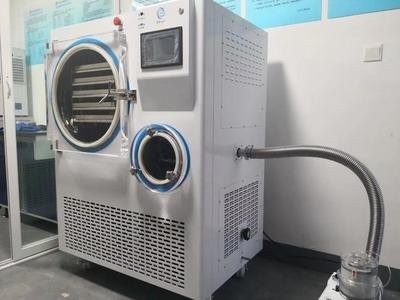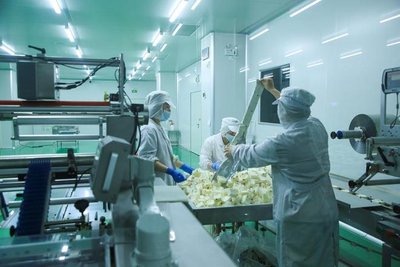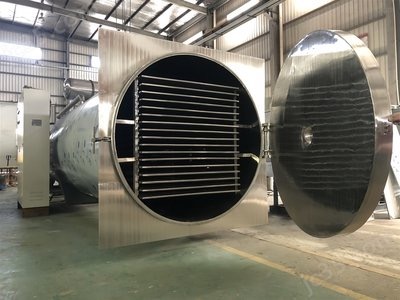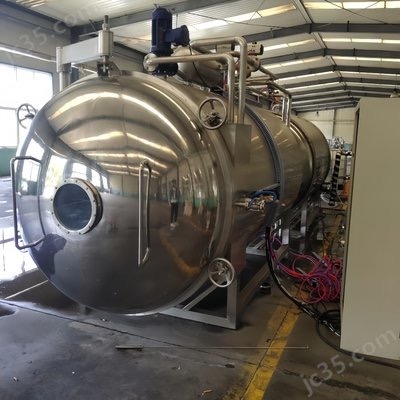
Content Menu
● Introduction to Freeze Drying Technology
● Understanding the Freeze-Drying Process
>> 1. Freezing
>> 2. Primary Drying (Sublimation)
>> 3. Secondary Drying (Desorption)
● The Anatomy of a Freeze Dried Food Commercial Machine
>> Drying Chamber
>> Condenser
>> Vacuum System
>> Heating System
>> Control System
● Advantages of Using a Freeze Dried Food Commercial Machine
>> Extended Shelf Life
>> Nutrient Retention
>> Flavor and Texture Preservation
>> Lightweight and Compact
>> Versatility
● Choosing the Right Freeze Dried Food Commercial Machine
>> Capacity
>> Energy Efficiency
>> Automation Features
>> Customization Options
>> Maintenance and Support
● Applications of Freeze Dried Food Commercial Machines
>> Food and Beverage Industry
>> Pharmaceutical Industry
>> Nutraceuticals
>> Pet Food Industry
>> Space Exploration
● The Future of Freeze Drying Technology
>> Increased Automation
>> Sustainable Operations
>> Hybrid Technologies
>> Miniaturization
● Best Practices for Operating a Freeze Dried Food Commercial Machine
>> 1. Proper Pre-Freezing
>> 2. Optimal Loading
>> 3. Regular Maintenance
>> 4. Process Monitoring
>> 5. Proper Packaging
● Conclusion: The Impact of Freeze Dried Food Commercial Machines
● Frequently Asked Questions
>> 1. What types of food can be processed in a freeze dried food commercial machine?
>> 2. How long does the freeze-drying process typically take in a commercial machine?
>> 3. Are freeze dried food commercial machines energy-efficient?
>> 4. How does the cost of freeze-drying compare to other food preservation methods?
>> 5. What maintenance is required for a freeze dried food commercial machine?
Introduction to Freeze Drying Technology
Freeze drying, also known as lyophilization, has emerged as a game-changing technology in the food industry. At the heart of this revolutionary process lies the freeze dried food commercial machine, an industrial freeze dryer capable of preserving large quantities of food while maintaining its nutritional value, flavor, and texture. This advanced food processing technology has transformed the way we approach food preservation, offering unparalleled shelf life and quality retention.
Understanding the Freeze-Drying Process
The freeze-drying process, facilitated by commercial freeze dried food machines, involves three main stages:
1. Freezing
The first step in the freeze-drying process is to freeze the product rapidly. This quick freezing helps to maintain the food's structure by forming small ice crystals.
2. Primary Drying (Sublimation)
During this phase, the freeze dried food commercial machine reduces the pressure and adds heat to allow the frozen water in the food to sublimate directly from a solid to a gas, bypassing the liquid phase.
3. Secondary Drying (Desorption)
In the final stage, the temperature is raised higher than in the primary drying phase to break any physicochemical interactions that have formed between the water molecules and the frozen material. This removes any remaining water molecules, leaving the product with minimal residual moisture.

The Anatomy of a Freeze Dried Food Commercial Machine
A typical industrial freeze dryer consists of several key components:
Drying Chamber
This is where the food is placed for processing. The chamber is designed to withstand extremely low pressures and can be temperature-controlled.
Condenser
The condenser collects the water vapor sublimated from the product, turning it back into ice.
Vacuum System
A powerful vacuum pump creates the low-pressure environment necessary for sublimation to occur.
Heating System
Controlled heat is applied to drive the sublimation process without melting the product.
Control System
Advanced computerized controls monitor and adjust the process parameters to ensure optimal results.
Advantages of Using a Freeze Dried Food Commercial Machine
Investing in a commercial freeze dryer offers numerous benefits for food manufacturers:
Extended Shelf Life
Freeze-dried products can last for years without refrigeration, making them ideal for long-term storage and emergency food supplies.
Nutrient Retention
The low-temperature process preserves most of the food's original nutritional value, vitamins, and minerals.
Flavor and Texture Preservation
Freeze-dried foods retain their original flavor and rehydrate to a texture very similar to their fresh counterparts.
Lightweight and Compact
By removing water, freeze-drying significantly reduces the weight and volume of food products, making them easier to transport and store.
Versatility
A wide range of foods can be freeze-dried, from fruits and vegetables to meats, dairy products, and even complete meals.
Choosing the Right Freeze Dried Food Commercial Machine
When selecting an industrial freeze dryer, consider the following factors:
Capacity
Determine the volume of food you need to process. Freeze dryer capacity can range from small batch processors to large-scale industrial units capable of handling thousands of kilograms per cycle.
Energy Efficiency
Look for energy-efficient freeze dryers that can help reduce operational costs without compromising on performance.
Automation Features
Advanced control systems can automate much of the process, improving consistency and reducing labor costs.
Customization Options
Some manufacturers offer customizable freeze dryers to meet specific product requirements or space constraints.
Maintenance and Support
Consider the availability of spare parts and technical support when choosing a commercial freeze dryer.

Applications of Freeze Dried Food Commercial Machines
The versatility of freeze-drying technology has led to its adoption across various industries:
Food and Beverage Industry
Freeze-dried fruits, vegetables, meats, and dairy products are popular for their long shelf life and convenience.
Pharmaceutical Industry
Freeze-drying is used to preserve sensitive medications and biologics.
Nutraceuticals
Many dietary supplements and functional foods are produced using freeze-drying technology.
Pet Food Industry
High-quality, nutrient-rich pet foods are increasingly utilizing freeze-dried ingredients.
Space Exploration
Freeze-dried foods are a staple for astronauts due to their light weight and long shelf life.
The Future of Freeze Drying Technology
As demand for high-quality, shelf-stable foods continues to grow, the freeze dried food commercial machine industry is evolving:
Increased Automation
Future freeze dryers are likely to incorporate more advanced automation and AI-driven controls for improved efficiency and consistency.
Sustainable Operations
Manufacturers are focusing on developing more energy-efficient models to reduce the environmental impact of freeze-drying operations.
Hybrid Technologies
Some researchers are exploring combinations of freeze-drying with other preservation methods to create even more effective food processing solutions.
Miniaturization
While industrial-scale machines dominate the market, there's growing interest in smaller, more accessible freeze dryers for smaller businesses and specialized applications.
Best Practices for Operating a Freeze Dried Food Commercial Machine
To ensure optimal performance and product quality, follow these best practices:
1. Proper Pre-Freezing
Ensure products are thoroughly and evenly frozen before starting the freeze-drying process.
2. Optimal Loading
Arrange products in the drying chamber to allow for efficient air circulation and uniform drying.
3. Regular Maintenance
Adhere to a strict maintenance schedule to keep all components of the freeze dryer in top condition.
4. Process Monitoring
Continuously monitor temperature, pressure, and time parameters throughout the freeze-drying cycle.
5. Proper Packaging
Use appropriate packaging materials to maintain the quality of freeze-dried products during storage and distribution.
Conclusion: The Impact of Freeze Dried Food Commercial Machines
The advent of commercial freeze dryers has revolutionized food preservation, offering unparalleled quality retention and shelf life extension. As technology continues to advance, we can expect even more efficient and versatile freeze dried food commercial machines to enter the market, further expanding the possibilities for food manufacturers and consumers alike. Whether you're a large-scale food producer or a specialized manufacturer, understanding and leveraging freeze-drying technology can open up new opportunities for product development and market expansion.

Frequently Asked Questions
1. What types of food can be processed in a freeze dried food commercial machine?
Answer: A wide variety of foods can be freeze-dried, including fruits, vegetables, meats, dairy products, complete meals, herbs, and even some beverages. The technology is versatile enough to handle most foods with high moisture content, making it suitable for everything from snacks to emergency food supplies.
2. How long does the freeze-drying process typically take in a commercial machine?
Answer: The duration of the freeze-drying process can vary depending on the type and quantity of food being processed, as well as the specific machine being used. Generally, a complete cycle in a commercial freeze dryer can take anywhere from 20 to 40 hours. Larger batches or foods with higher moisture content may require longer processing times.
3. Are freeze dried food commercial machines energy-efficient?
Answer: While freeze-drying is an energy-intensive process due to the need for maintaining low temperatures and high vacuum conditions, modern commercial freeze dryers are designed with energy efficiency in mind. Many manufacturers now offer energy-efficient models that incorporate features like heat recovery systems, improved insulation, and optimized process controls to reduce overall energy consumption.
4. How does the cost of freeze-drying compare to other food preservation methods?
Answer: Initially, freeze-drying can be more expensive than other preservation methods due to the high cost of equipment and energy use. However, when considering the extended shelf life, reduced storage and transportation costs, and premium quality of the final product, freeze-drying can be cost-effective in the long run, especially for high-value foods or large-scale operations.
5. What maintenance is required for a freeze dried food commercial machine?
Answer: Regular maintenance is crucial for the optimal performance and longevity of a commercial freeze dryer. This typically includes:
- Daily cleaning of the chamber and shelves
- Regular inspection and replacement of gaskets and seals
- Periodic oil changes for the vacuum pump
- Calibration of sensors and controls
- Inspection and cleaning of the condenser
- Checking and maintaining the refrigeration system
It's important to follow the manufacturer's specific maintenance guidelines for your particular model of freeze dryer.












